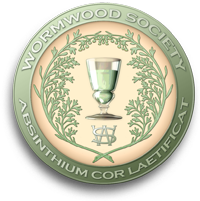What To Look For In An Absinthe - Reviewed by Experts and Consumers at The Wormwood Society
What To Look For In An Absinthe
 As the absinthe market in the U.S. continues to expand, consumers are increasingly left with difficult decisions regarding which absinthe they should buy. Unfortunately, the lack of a formal spirit definition for absinthe in this country has left the door open for many lower quality and/or fake products to be placed right next to the best of the best, many times priced the same or even higher than their higher quality counterparts. So, with that in mind, here are a few pointers that can help you avoid buying a $70 bottle of drain cleaner:
As the absinthe market in the U.S. continues to expand, consumers are increasingly left with difficult decisions regarding which absinthe they should buy. Unfortunately, the lack of a formal spirit definition for absinthe in this country has left the door open for many lower quality and/or fake products to be placed right next to the best of the best, many times priced the same or even higher than their higher quality counterparts. So, with that in mind, here are a few pointers that can help you avoid buying a $70 bottle of drain cleaner:
Color: If it’s artificially colored, don’t buy it. You wouldn’t buy wine that said ‘colored with FD&C so-and-so’, would you? Same goes with absinthe. If it’s artificially colored, it stands to reason that it will be of lower quality. Any brand labeled for U.S. sales must state on the label whether it has artificial coloring in it. A distilled, naturally colored absinthe will say something like: “Grain Neutral Spirits (or grape or beet, etc etc) distilled with herbs and colored with herbs”. An artificially colored absinthe will say somewhere on the label “Contains FD&C so-and-so”. Keep in mind there are also clear absinthes, which do not go through the additional coloration step. These are known as La Bleue or Blanche style absinthes.
Type: Most absinthes sold in the U.S. will have some telltale signals as to which production method was used to create it. Distilled absinthes tend to be of higher quality, whose labeling is mentioned above. A label example of compounded absinthe (made by adding essential oils to the base alcohol instead of distilling the herbs) might say “Grain Neutral Spirits with Natural Flavors Added”. CAVEAT: Some traditionally colored and distilled absinthes may have ‘natural flavors added’ on the label as well, so this shouldn’t be the be-all-and-end-all point to consider. Macerated absinthes (those that have herbs soaked in alcohol and not redistilled) label might say something like “Spirits with Herbs added”. Macerates have very little in common with authentic absinthe.
Thujone levels: Products that tout thujone content are looking to make a buck off of the drug culture, trying to promote absinthe as something other than alcohol. Any references or comparisons to other drugs such as cannabis should also show you what the producers are focusing on. These products should be avoided if you’re looking to buy historically accurate absinthe.
Sugar: Absinthe is a dry spirit, with sugar added at the discretion of the consumer. It should NEVER be bottled with sugar added. A telltale sign that it contains sugar will be the word ‘LIQUEUR’ on the label. In the US, this signifies added sugar.
